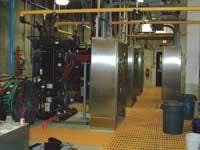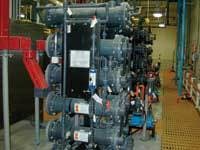The River Mountains Water Treatment Facility (WTF) is one of two plants that provide drinking water to the Las Vegas Valley. In 1998, the facility was designed to produce 150 million gallons per day (mgd) and included provisions for subsequent 150 mgd expansions, up to 600 mgd if more supply was needed. The current capacity of the River Mountains WTF is 300 mgd.
Owned and operated by the Southern Nevada Water Authority (SNWA), the facility treats surface water and includes secondary chlorination to maintain a residual in the distribution system. The SNWA decided to install an on-site hypochlorite solution system to alleviate safety concerns associated with using chlorine gas or commercial sodium hypochlorite solutions. The plant is sited less than a quarter-mile from a residential neighborhood in the City of Henderson.
The Authority’s consultant, MW/Hill, recommended installing the OSEC® On-site Electrolytic Chlorination System from Siemens Water Technologies. Three 2000 ppd OSEC hypochlorite generators started up in November 2003, and another six started up in March 2006. The nine systems comprise the largest brine-based hypochlorite generators in North America, with an installed capacity of 18,000 lb/d of equivalent chlorine.
Overcoming Challenges
“Siemens supplied a reliable system that met the Authority’s special control system requirements and engineering challenges,” said Scott Boettcher, project design manager for MW/Hill. “With a treatment facility this size and located so close to the neighbors, safety was a paramount concern.”
The equipment layout constraints, special seismic considerations, control system requirements and customization, documentation and quality control also proved challenging, Boettcher said. For example, in order to reduce the building size, the power rectifiers were installed one floor above the generator room. The bus connections for the rectifier and generator needed to go through the concrete floor in the rectifier room and join the generators below.
In addition, SNWA required the plant to be recessed into the hillside as much as possible. The large concrete OSEC storage tanks and brine tanks were constructed below grade. The delivery of salt is facilitated by this arrangement because trucks drive over the salt pits and gravity dump their loads.
On-Site Generation
Each 2000 ppd OSEC system is comprised of a hypochlorite generator, transformer/rectifier, a local control panel, a brine pump, and motorized valves, all for automatically generating sodium hypochlorite.
Each sodium hypochlorite generator is made up of two parallel sets of four tubular electrolyzer casings mounted on a freestanding pedestal. These four casing sets are connected in series and house a titanium chassis to which the anodes and cathodes are fixed. The internal electrolyzer design and vertical orientation of the anode and cathode plates ensure maximum efficiency by quickly removing hydrogen from the inter-electrode gap. This ultimately results in electrical power and salt savings. The anodes have a seven-year warranty.
Each generator includes two optional shell and tube heat exchangers. These are pre-piped and pre-mounted to the top of the generator assembly. The heaters remove heat from the hypochlorite solution exiting the generator and transfer this heat to the incoming cold water. The heat of reaction from the generation process increases the product temperature as much as 20°F from the brine solution temperature.
Optimum efficiency of the generation process occurs when incoming water temperature is at least 50°F. Using a heat exchanger can increase incoming solution temperatures by an average of 7°F, which will improve efficiency without consuming any electricity. The heat exchanger can be bypassed during warm-season operation when incoming solution temperatures are higher.
The OSEC generator’s split flow design separates incoming dilution water into two streams. The first dilution water stream is precisely metered so that it provides a favorable brine concentration and enhanced operating temperature at the start of the generation process. The rest of the cool dilution water is added later in the process to maintain the operating temperature within the most efficient range to achieve the final product concentration. To maintain proper conditions for safe and efficient operation, the generators include sensors for brine flow, water flow, level, and inlet and outlet temperatures.
The OSEC systems at River Mountains WTF were installed in two phases. Phase 1 was commissioned in 2002, and Phase 2 was commissioned earlier this year. Each phase is controlled by a Master PLC control panel that provides run permissives to each of the generator’s local PLC control panels. Each master and local control panel includes an HMI (Human/Machine Interface) to visually verify complete system status and parameters.
Any alarm condition such as storage tank overflow, high electrolyte temperature, improper voltage, or low brine flow that affects the consistent production of sodium hypochlorite shuts the system down. The last 200 events are logged, making it easier to troubleshoot operating conditions. The entire generation process for both phases is controlled and monitored via the facility’s SCADA system that communicates with the PLCs via fiber optics.
A solid-state-controlled, force-air-cooled transformer/rectifier provides power for each generator. The rectifier is self-monitoring for cell voltage, thermal overload and internal faults. An alarm contact interfaces with the OSEC control panel to maintain proper system operation.
The freshly produced sodium hypochlorite solution is stored in four site-erected PVC-lined concrete tanks. Milltronics ultrasonic level sensors from Siemens are mounted on each sodium hypochlorite storage tank. These instruments provide start/stop control of the OSEC process to maintain a continuous supply of hypochlorite. A primary air dilution blower and a redundant standby blower force-ventilate the storage tank to reduce the concentration of hydrogen gas. Unless air flow is maintained through the storage tanks, the hypochlorite production process is shut down to prevent hydrogen gas from accumulating above the LFL (Lower Flammability Limit).
The brine saturator tanks create the brine solution that feeds each OSEC generator. The saturated brine solution is made by passing softened water through a salt bed. A brine dosing pump then feeds the resulting saturated brine solution to each generator. To facilitate salt deliveries to the site, MW/Hill designed underground lined concrete tanks allowing for bulk salt delivery by gravity. In addition, the underground tanks reduce the sensitivity of brine to temperature, eliminating the need for insulation and heat tracing typically required for above-ground tanks.
Results
To date, the OSEC system’s performance has exceeded the authority’s expectations. The system consumes only 3.1 lb of salt / lb of chlorine and less than 2.0 kWh / lb of chlorine.
Despite only recently completing Phase 2 of the River Mountains facility expansion, SNWA is already planning for Phase 3, which will increase the facility’s capacity to 600 mgd.
About the Authors
Alberto Garibi is the OSEC product manager at Siemens Water Technologies, located in Miami, Fla. He can be contacted at 305-567-0596 or at [email protected]. Bruce Figueroa is a project engineering manager with Siemens Water Technologies in Vineland, N.J. He can be reached at 856-507-4058 or at [email protected].




